Disclaimer: This post may contain affiliate links, meaning we get a small commission if you make a purchase through our link at no extra cost to you. For more information, please visit our Disclaimer Page.
How to use Semrush tool? You may have been trying to rank your blog on google. You’ve done your research and have heard of SEMRush. What is SEMrush? Is it worthwhile to use Semrush?
If you haven’t yet started your blog. Follow this detailed guide that walks you through step by step on how to set up your blog.
Today, I’m going to lay it all out on the table because keyword research is important.
Imagine checking your website to make sure there are no errors and optimizing your website, getting loads of free organic search traffic.
Semrush is the go-to tool for seeing what your competitors are ranking for, discover more keywords to rank for and outperform the competitors, see how you can improve your website, and lots more.
Who is SEMRush For?
SEMRush is for you if you’re :
- Bloggers
- Content Creators
- Influencers
- Marketing Agencies
Let’s dig a little deeper.
Table of Contents
Best SEMRush features:
Site Audit tool
You can also run a site audit on your website in SEMrush to see if it has any problems that could perhaps affect its performance and it gives you general suggestions about what you can do to fix the errors.
You simply go to site audit, type in your URL in the domain area and it produces the audit report.
Position Tracking:
SEMRush Position tracking feature helps you to track the keywords that have and the position they are ranking for.
In this SEMrush position tracking, you will see all keywords you are currently ranking for. It basically tracks the keywords that are bringing traffic to your website and also and the amount of monthly search it gets. (search volume metrics).
Keyword Magic Tool:
The Keyword Magic tool from SEMrush is an amazing feature to discover keywords that will get your content seen.
From your main keyword (root-word), you can get a long list of keywords that you can captivate on that your competitor has not.
You can choose whether you want the word to be a broad match, phrase match, exact match, and related keywords.
From this search you get
- Long-tail keywords option to choose from
- Average volume searches for keywords
- A graph that shows how trending the keyword is.graph
- It gives you Keyword difficulty
- CPC (the average cost advertisers would rank that word
One of the good things about SEMrush is that it has a question option that shows you the question that people ask based on your root keyword.
It asks questions related to who, what, why, when, where, and how questions people type in for that keyword.
On-Page SEO Checker
This On-Page SEO Checker is essentially useful because what it does is analyze the pages of your website and then give you valuable information about what you can do to improve your SEO.
The tool gives you substantial information on what affects your website’s performance, gives you a real and practical suggestion based on the information it collects, and shows you a comparison between the pages that are ranked in the top 10 on google.
This way you strategically plan the keywords that you want to rank for both on-page and off-page SEO.

Semrush how to do keyword research- Organic Search
A good way to do keyword research is through spying out the keywords your competitor is ranking for and do a better job at it. This is through organic search.
SEMrush makes keyword research so much easier, if you’ve never done keyword research before, and want to find easy words to start getting traffic, use the ones that your competitors are ranking for.
Rest assured that SEMRush tells it all.
To do this :
Go to organic research, type the domain for your competitor in the search box after you go to organic search.
You can see the exact word they are ranked for, how they are positioned and the amount of search it gets, if this isn’t a goldmine, I don’t know what it is.
Once you’re a serious blogger or into any form of content creation, this tool needs to be in your back pocket so you can draw it out and use it at any time.
Take a close look at it.
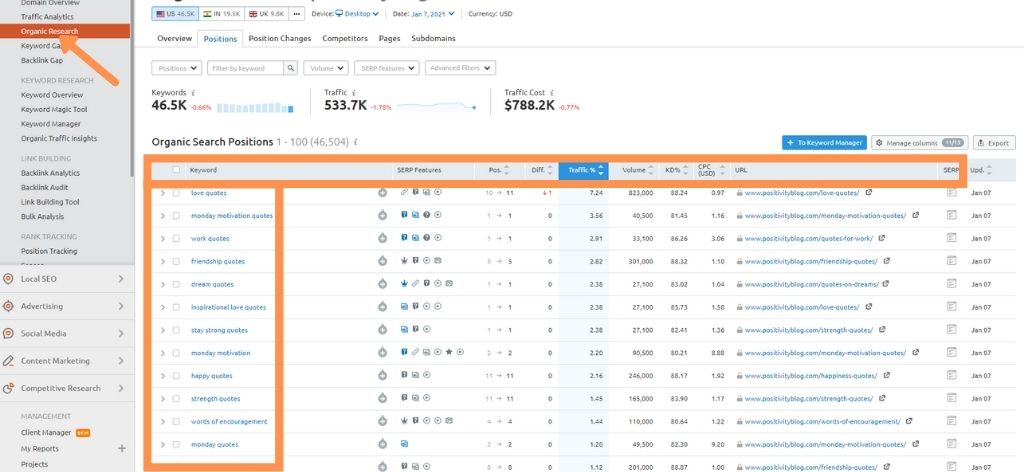
Let me explain some important features in this report.
Keyword: The keywords that the domain is ranking for ranked. You can go through the list and choose from that list of keywords.
Pos: This shows how a particular keyword is ranked (positioned) in the search engine. For this example, It is showing Google’s database for US location.
Volume: This is the actual number of match queries for that keyword in the local search. This is showing results from Google’s US database.
CPC: This is the Average cost per click for keywords.
URL: This shows the direct URL page that the keyword is driving traffic to.
Results: Number of search engine results. (A lower number here is better.)
KD-Keyword Difficulty. It shows how easy that keyword can be outranked.
SERP – When you click on this, you will see the results as they appear on Google pages.
So the higher the number (70 and above) is harder to outrank in the search engines. but a perfect score KD would be anything below 69.

How to use SEMRush Tool
SEMRush has a lot of features that can in a very short time gain authority in search engines. Of all the features though, you will be using SEMRush for keyword research mostly because you want people to find you–Oh yeah you do.
I’m going to show in detail how to use the SEMRush keyword magic tool.
Using semrush for keyword research –
Semrush Keyword Magic Tool
Apart from using organic search to see what keyword your competitors are ranking for. You can come up with new fresh keywords to search for.
That is where the SEMRush keyword magic tool comes in.
You will quickly get metrics such as the volume, trends, keyword difficulty, cost-per-click, SERP features, Results in SERP (which is the total amount of results that has those specific keywords). So what should you do first?
1. Choose a root keyword
Once you’ve identified the topic you want to dive into, you need to find keywords that will allow your content to be seen by your ideal audience.
First, you should choose a keyword that will act as a root to flesh out related keywords. You should start with a keyword that is generally related to the topic you want to write about.
Let us look at Affiliate Marketing.
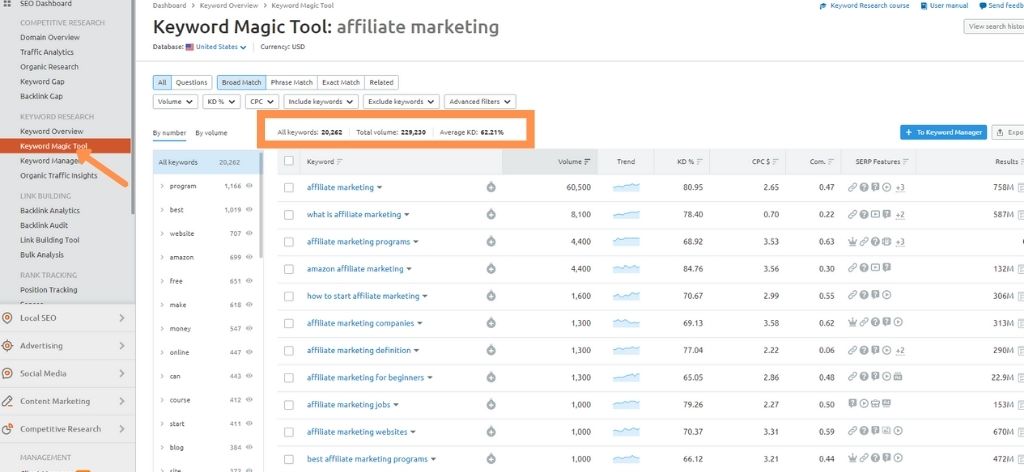
As you can see from the result, it returned 20,262 results which is a lot of keywords to choose from.
What you will need to do is to filter the results to get easier keywords to target.
If you want to choose a long-tail keyword with a specific word associated with your root word, you can click on each word under all keywords to give results only with that word so for example, if you click on the word “best”, it will only show “best affiliate marketing keywords.”
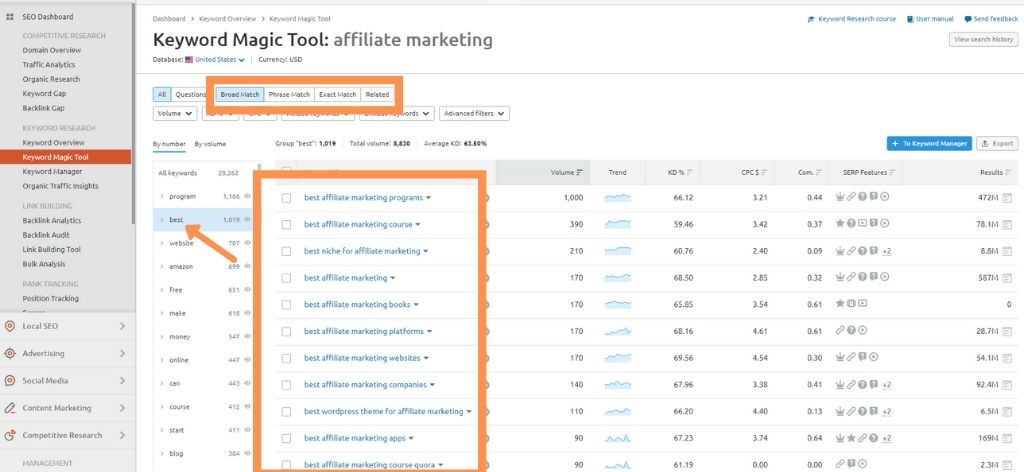
2. Adjust match modifiers
The tool will show you all keywords related to your search. Based on the search results, you may want to narrow these down.
From the results you can choose from the following:
You can also see broad match which gives general information.
The phrase match shows phrases that have the keywords in them.
The exact match shows results for the exact keyword.
Related match related feature of Keyword magic tool which is going to show words similar that you wouldn’t have thought of otherwise.
To access this tool, go to Keyword Analytics.
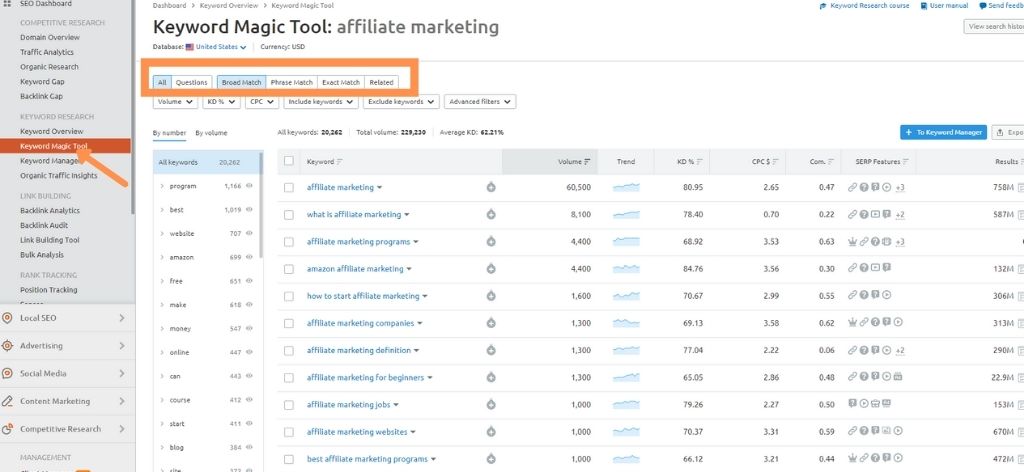
You can especially f you have a new blog, there’s no way you can after high competitive world like affiliate marketing for example, and expect to be ranked.
3. Apply advanced Filters
SEMRush Keyword magic Tool shows you all of keywords that it can find related to your search. Based on the results, you may want to tweak the results a little.
There are far too many websites with years of experience and rank that will outperform you. What you need to do is find low competitive keywords.
To make it easier to find low hanging fruits. You can apply advanced filters to your search.
I generally recommend that you apply at least 3 filters to your searches.
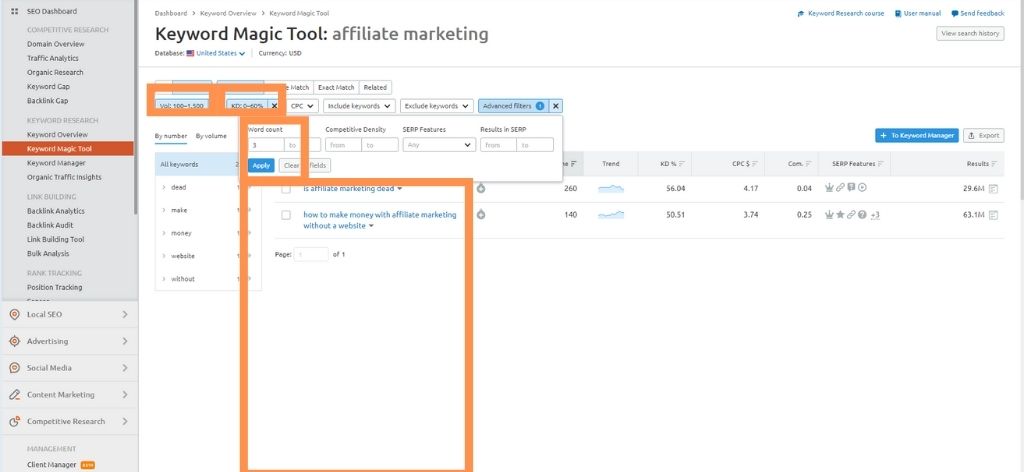
Filter by Volume:
Authoritative websites tend to go after and are ranked well for keywords that have a high volume so I recommend filtering the volume from 100-2000.
Filter by KD
Keywords with a difficulty score of 70 and over are hard to rank so try to find keywords with a minimum of 0-69.
Filter by long-tail keyword.
It is easier to rank for longtail keywords so what you should do is a filter to find keywords with a minimum of 3 words.
If you do this, you can start ranking for keywords in no time and dominate search engines.
4. Export your ideal keywords
When you’ve found the keywords that you would like to target, you can select them by clicking on the boxes right next to each of those keywords. After that, you can simply move them over as a list to the SEMRush Keyword Manager.
Watch this video tutorial for more insights.
Why should you start using the SEMrush keyword magic tool now?
Imagine spending hours after hours writing a blog post to see an increase in our traffic. Ever so often, that doesn’t happen. We often fail to do the detailed, in-depth search necessary to find the ideal keywords to rank.
That is partly because the free or lower-cost keywords research tools that are often used have just not been effective and informative.
The beauty of SEMRush is that when use I, you can find keywords that bring traffic to your competitor’s website, and then you can creatively and uniquely write more in-depth quality posts based on those keywords. This is GOLD.
This will most definitely help you stand a chance to rank for keywords within your niche.
If you want to handle all of the SEO for your content then SEmrush is the solution. This is the best keyword research tool you can ever find.

Benefits that you can get from using SEMrush.
You’ll get to understand how your website is performing.
Sometimes when you’re putting out material, it takes a while to show results. However, you can get insights on how your website is performing, see what’s working and get recommendations on what to do.
In SEMRush, you can see the keywords that your website is ranking for. This allows you to optimize your content in such a way that you’re always ranking for keywords and rank better for them.
You’ll find valuable keywords
The right Keywords that you select can either make or break your business. Needless to say, this is a vital aspect of your business.
Whenever your target audience is searching, they have a certain intention, you need to feed into that intent and ensure they find you.
Using SEMRush for keyword research will allow you to tap into that.
Try to focus on long-tail keywords typically three or more words. You stand a better chance to rank for Long-tail keywords that work in your favor for SEO.
This way you drive leads to your business.
You’ll understand your competition
In this world of SEO, you need to see what your competition is up to. Bear in mind that many businesses are trying to rank for similar words as well so you need to see what they are doing to be a few steps ahead of them.
By learning how to do keyword research using SEMRush, you can learn from the competition that is performing better.
Go digging for some keywords that they are getting traffic from.
Please take advantage of this fact and apply those keywords to your SEO strategy.
While SEMRush offers these features, it is up to you to put in the work and do your research so you can dominate.
SEMRush offers a free trial, you can try it out to see how it works.
SEMrush pricing
You might be thinking that this is too costly When deciding whether or not to pay for SEMrush, especially for a monthly fee.
Let me be real with you though, SEMrush has so many features that you literally can’t find anywhere else, and every aspect of SEMRush is designed to ensure that you get back the return on the money that you’ve invested.
These are the packages.
- Pro – $99.95 per month. Designed for small businesses and startups.
- Guru – $199 per month. This is good for medium-sized business and agencies as well
- Business – $399.95 per month. The perfect package for agencies, large businesses, and eCommerce.
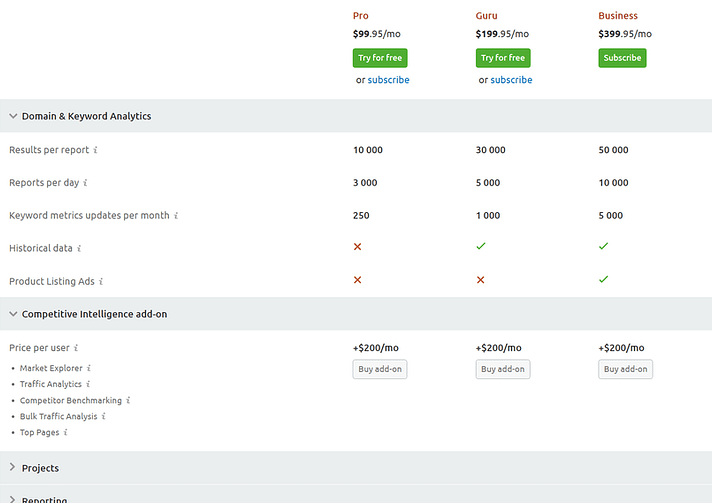
The prices listed are monthly prices. What’s amazing is you can save 16% if you choose the annual plan.
There’s also a 7-day free trial that allows you to get a feel of how it works.
Pros
- It allows you to easily benchmark against your competitor
- It has a thorough keyword research tool
- Can be used for various business
- One-stop-shop for everything SEO.
- They give you a free trial option
Cons
Semrush has a lot of features and at fist it can seem overwhelming.
Conclusion:
From the above guide on how to use SEMRush tool, you have seen that it is a powerful tool to use even if you’re new to content marketing.
The SEMRush features highlighted shows that you can do a lot to improve how your post performs.
Aren’t you tired of writing posts that don’t get ranked and seen by your target audience?
Do you want to see your business perform better? You need to tap into this SEO treasure that the features of SEMRush offers.
This is information at your finger like never before from SEMRush. Choose a plan that will make your business boom in no time.
I hope this review on how to use Semrush keyword tool has helped you to understand how SEMRush can grow your business.
While SEMrush is useful for research, it still takes effort on your part to actively research to get you appearing on the top pages.
What do you think about SEMRush keyword research tool?
Comment below.







